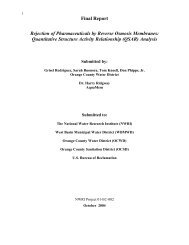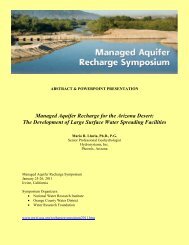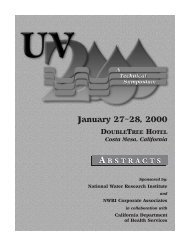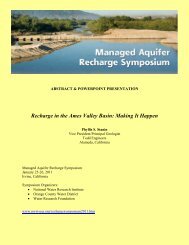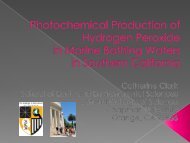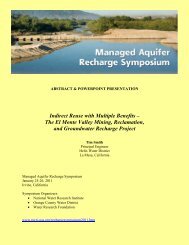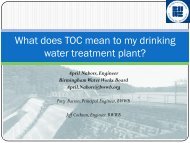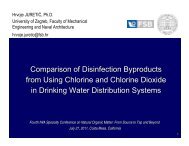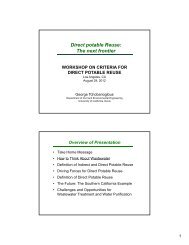RBF_Cover (for eps) - National Water Research Institute
RBF_Cover (for eps) - National Water Research Institute
RBF_Cover (for eps) - National Water Research Institute
Create successful ePaper yourself
Turn your PDF publications into a flip-book with our unique Google optimized e-Paper software.
194<br />
During the field investigation program, hydrogeological, hydraulic, hydrological, chemical,<br />
physico-chemical, biological, and microbiological data were collected and evaluated. The results of<br />
the water-quality studies revealed characteristic quality changes in the filter media: the chemical<br />
oxygen demand concentration gradually decreased from the river towards abstraction sites,<br />
indicating the decomposition of organic pollutants. Hydro-biological studies indicated that the<br />
Danube River had considerable fecal coli<strong>for</strong>m pollution, but that bacteria removal during <strong>RBF</strong> was<br />
very efficient. Coliphages used as indicators of virus pollution were also measured. The results of<br />
these tests verified that coliphages were not able to pass through filter media.<br />
The retardation of specific organic micropollutants is very different depending on their biodegradability,<br />
sorption affinity, etc. The mobile, persistent organic micropollutants (e.g., atrazine,<br />
simazine, trichloroethene, and benzene) have low removal efficiency (less than 30 percent); on<br />
the other hand, some pesticides (e g., terbutrin, 2,4-D, and carbaryl) and petroleum hydrocarbons<br />
are removed substantially. The retardation or remobilization of some heavy metals is influenced<br />
by redox conditions.<br />
Adsorption experiments in the laboratory provided in<strong>for</strong>mation on the partition coefficients of<br />
various micropollutants between spiked Danube water and the material of filtration medium taken<br />
from <strong>RBF</strong> sites (Laszlo and Literathy, 2002). Two riverbed materials were used: one represented the<br />
sandy alluvium having low organic material; the other was taken from a sedimentation zone of the<br />
riverbed where river water infiltrates through sediment having high organic material content and fine<br />
particle size. The partition coefficient varied widely <strong>for</strong> the different organic micropollutants and<br />
heavy metals, depending mainly on the character of the pollutants. The type of bed material was also<br />
important: the partition coefficients were higher in silty riverbed material than in the sandy matrix<br />
<strong>for</strong> all pollutants.<br />
Numerical transport modeling — based on measured hydraulic, hydrogeological, and physicochemical<br />
parameters — concluded that relatively short-duration accidental pollution has limited<br />
risk <strong>for</strong> <strong>RBF</strong> schemes along the Danube River due to a wide range of travel times from the river to<br />
abstraction wells. Higher risk would be long-lasting, continuous pollution of the Danube.<br />
Another concern is the impacts of river training and gravel dredging on the quality of riverbankfiltered<br />
water (Laszlo et al., 1990). Training structures (groynes, parallel dykes) and dredging<br />
operations affect the hydraulic conditions in the river that are conducive to silting in areas with<br />
reduced flow velocities. Adverse hydrochemical changes occur in the silted filter layer, especially<br />
the dissolution of iron and manganese, and higher concentrations of ammonium are observable.<br />
Bed degradation owing to dredging causes changes in the inflow ratio to the abstraction wells,<br />
increasing the proportion of polluted groundwater from the background areas in the wells.<br />
Conclusions<br />
<strong>RBF</strong> has been an effective method <strong>for</strong> drinking-water supply in Hungary <strong>for</strong> a long time.<br />
The sustainability of <strong>RBF</strong> abstraction schemes depends on several factors, including the quality of<br />
river water, characteristics of the filtration media, retention time within the aquifer, and quality<br />
of the groundwater adjacent to the extraction site.



